Comprehensive Analysis of Mental Health Treatment in Australia
VerifiedAdded on 2022/11/15
|8
|2234
|161
Report
AI Summary
This report provides a comprehensive overview of mental health treatments in Australia. It discusses the increasing prevalence of mental health problems and emphasizes the importance of focusing on individual recovery. The report highlights the role of the biomedical model and the significance of hope and self-management in the recovery process. It details various initiatives by the Australian government, including the Partners in Recovery program and the Fifth National Mental Health and Suicide Prevention Plan. The report also explores specific treatments such as cognitive behavioral therapy (CBT), psychoeducation, and the use of neuroleptics. A case study of Mrs. X, a 71-year-old woman with major depressive disorder, is presented to illustrate the application of psychoeducation as a treatment approach. The report concludes that psychoeducation, along with other therapeutic interventions, plays a crucial role in addressing mental health challenges in Australia. It also touches upon the role of community nurses and the importance of lifestyle changes in supporting mental well-being.
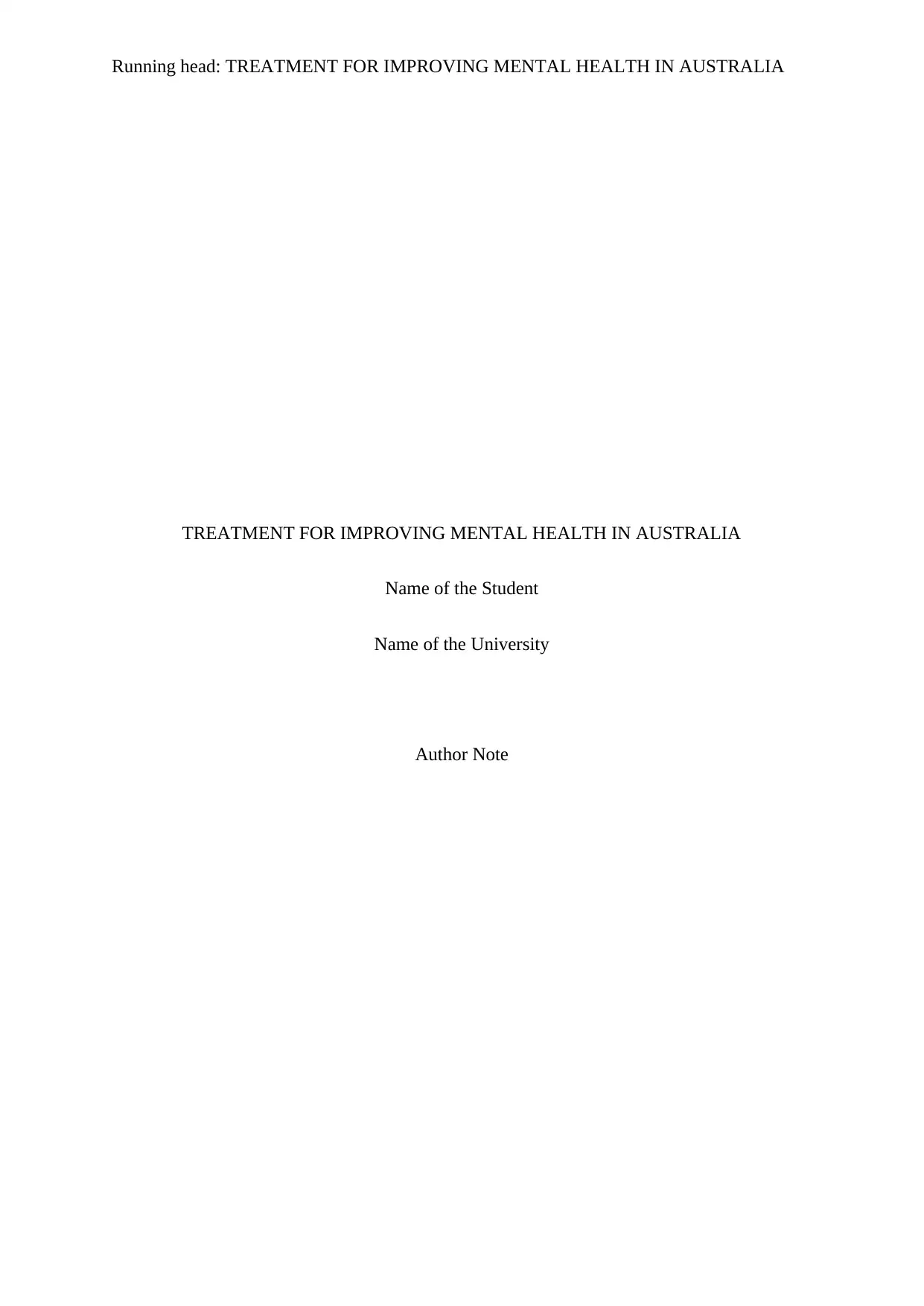
Running head: TREATMENT FOR IMPROVING MENTAL HEALTH IN AUSTRALIA
TREATMENT FOR IMPROVING MENTAL HEALTH IN AUSTRALIA
Name of the Student
Name of the University
Author Note
TREATMENT FOR IMPROVING MENTAL HEALTH IN AUSTRALIA
Name of the Student
Name of the University
Author Note
Paraphrase This Document
Need a fresh take? Get an instant paraphrase of this document with our AI Paraphraser
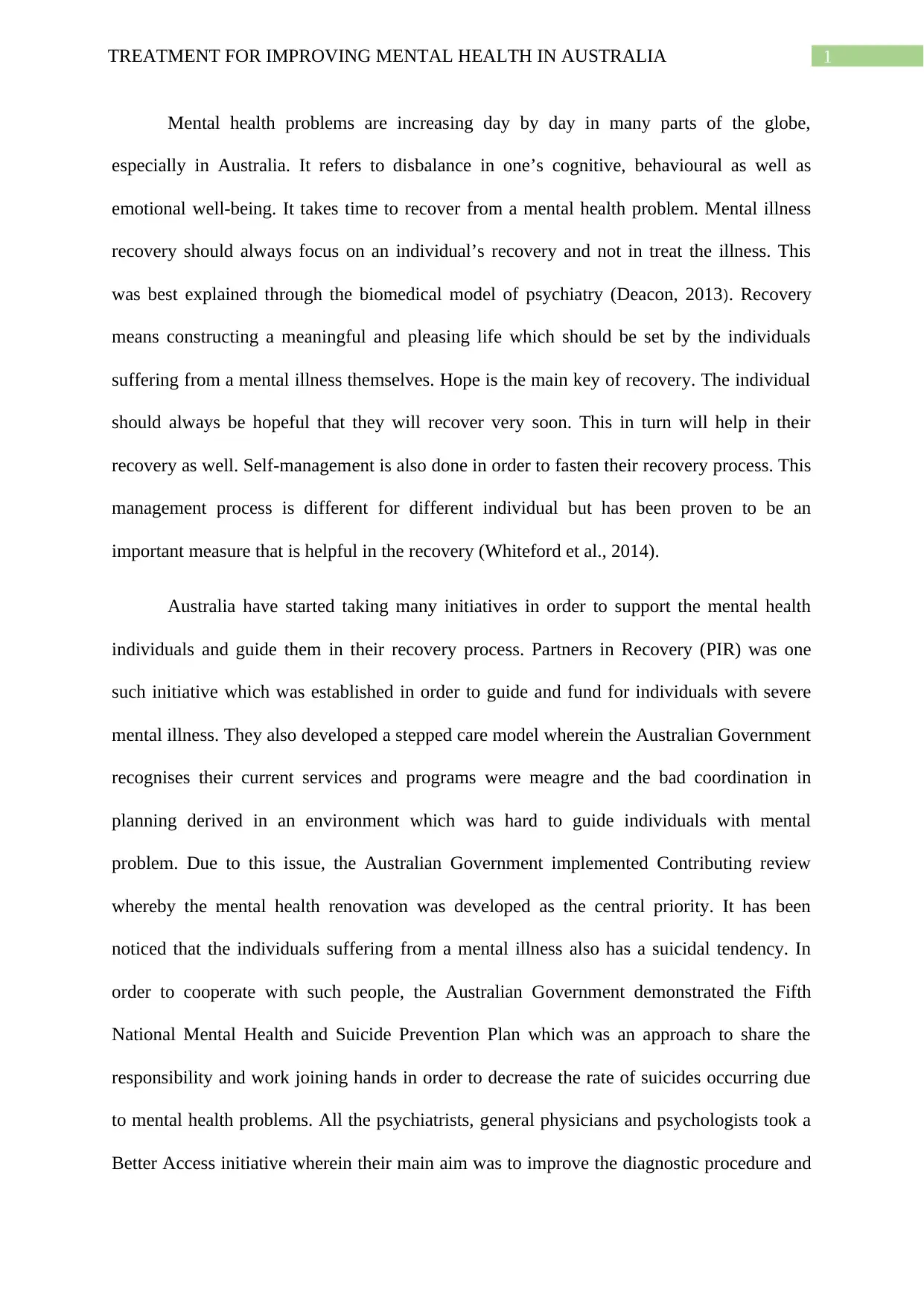
1TREATMENT FOR IMPROVING MENTAL HEALTH IN AUSTRALIA
Mental health problems are increasing day by day in many parts of the globe,
especially in Australia. It refers to disbalance in one’s cognitive, behavioural as well as
emotional well-being. It takes time to recover from a mental health problem. Mental illness
recovery should always focus on an individual’s recovery and not in treat the illness. This
was best explained through the biomedical model of psychiatry (Deacon, 2013). Recovery
means constructing a meaningful and pleasing life which should be set by the individuals
suffering from a mental illness themselves. Hope is the main key of recovery. The individual
should always be hopeful that they will recover very soon. This in turn will help in their
recovery as well. Self-management is also done in order to fasten their recovery process. This
management process is different for different individual but has been proven to be an
important measure that is helpful in the recovery (Whiteford et al., 2014).
Australia have started taking many initiatives in order to support the mental health
individuals and guide them in their recovery process. Partners in Recovery (PIR) was one
such initiative which was established in order to guide and fund for individuals with severe
mental illness. They also developed a stepped care model wherein the Australian Government
recognises their current services and programs were meagre and the bad coordination in
planning derived in an environment which was hard to guide individuals with mental
problem. Due to this issue, the Australian Government implemented Contributing review
whereby the mental health renovation was developed as the central priority. It has been
noticed that the individuals suffering from a mental illness also has a suicidal tendency. In
order to cooperate with such people, the Australian Government demonstrated the Fifth
National Mental Health and Suicide Prevention Plan which was an approach to share the
responsibility and work joining hands in order to decrease the rate of suicides occurring due
to mental health problems. All the psychiatrists, general physicians and psychologists took a
Better Access initiative wherein their main aim was to improve the diagnostic procedure and
Mental health problems are increasing day by day in many parts of the globe,
especially in Australia. It refers to disbalance in one’s cognitive, behavioural as well as
emotional well-being. It takes time to recover from a mental health problem. Mental illness
recovery should always focus on an individual’s recovery and not in treat the illness. This
was best explained through the biomedical model of psychiatry (Deacon, 2013). Recovery
means constructing a meaningful and pleasing life which should be set by the individuals
suffering from a mental illness themselves. Hope is the main key of recovery. The individual
should always be hopeful that they will recover very soon. This in turn will help in their
recovery as well. Self-management is also done in order to fasten their recovery process. This
management process is different for different individual but has been proven to be an
important measure that is helpful in the recovery (Whiteford et al., 2014).
Australia have started taking many initiatives in order to support the mental health
individuals and guide them in their recovery process. Partners in Recovery (PIR) was one
such initiative which was established in order to guide and fund for individuals with severe
mental illness. They also developed a stepped care model wherein the Australian Government
recognises their current services and programs were meagre and the bad coordination in
planning derived in an environment which was hard to guide individuals with mental
problem. Due to this issue, the Australian Government implemented Contributing review
whereby the mental health renovation was developed as the central priority. It has been
noticed that the individuals suffering from a mental illness also has a suicidal tendency. In
order to cooperate with such people, the Australian Government demonstrated the Fifth
National Mental Health and Suicide Prevention Plan which was an approach to share the
responsibility and work joining hands in order to decrease the rate of suicides occurring due
to mental health problems. All the psychiatrists, general physicians and psychologists took a
Better Access initiative wherein their main aim was to improve the diagnostic procedure and
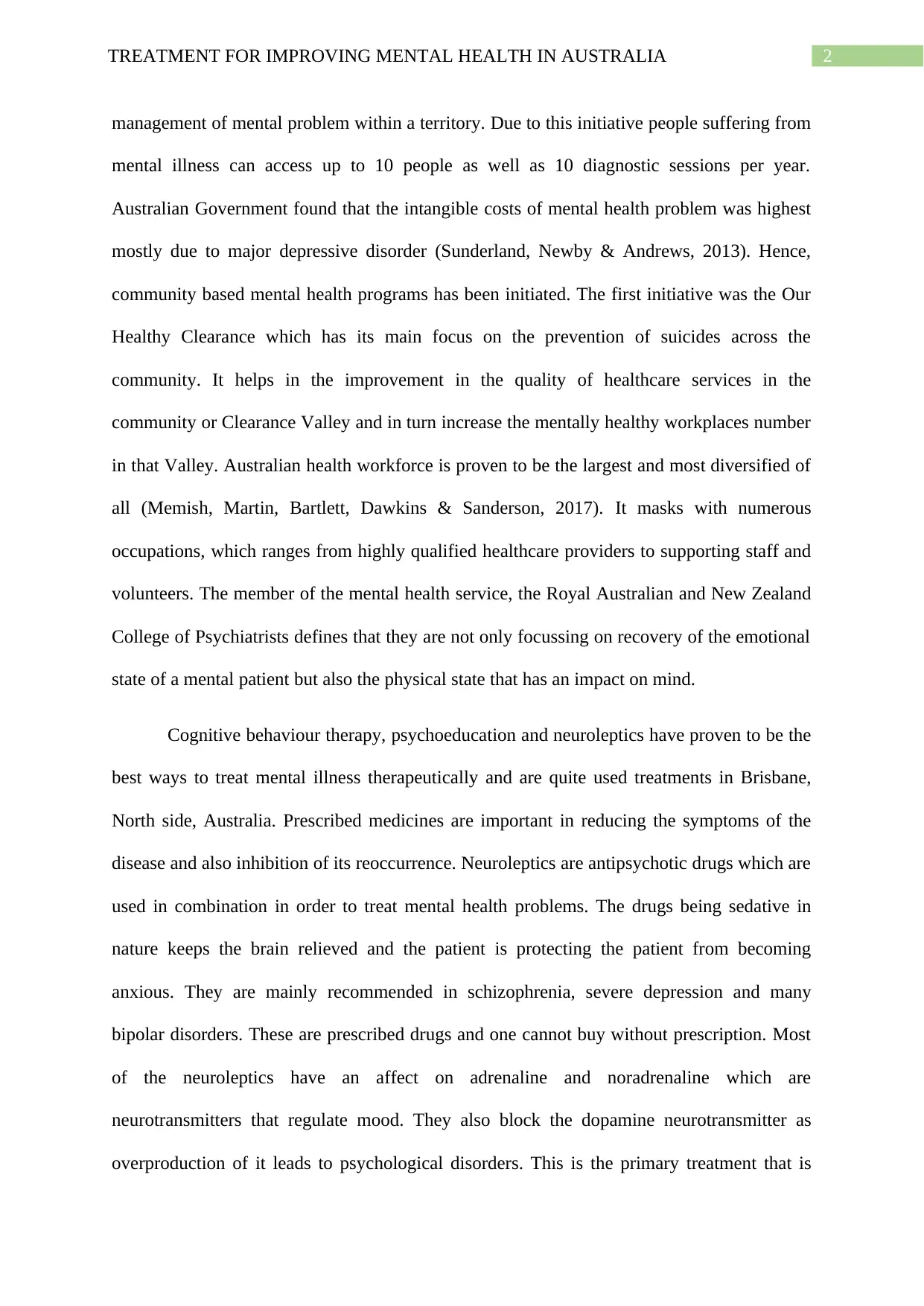
2TREATMENT FOR IMPROVING MENTAL HEALTH IN AUSTRALIA
management of mental problem within a territory. Due to this initiative people suffering from
mental illness can access up to 10 people as well as 10 diagnostic sessions per year.
Australian Government found that the intangible costs of mental health problem was highest
mostly due to major depressive disorder (Sunderland, Newby & Andrews, 2013). Hence,
community based mental health programs has been initiated. The first initiative was the Our
Healthy Clearance which has its main focus on the prevention of suicides across the
community. It helps in the improvement in the quality of healthcare services in the
community or Clearance Valley and in turn increase the mentally healthy workplaces number
in that Valley. Australian health workforce is proven to be the largest and most diversified of
all (Memish, Martin, Bartlett, Dawkins & Sanderson, 2017). It masks with numerous
occupations, which ranges from highly qualified healthcare providers to supporting staff and
volunteers. The member of the mental health service, the Royal Australian and New Zealand
College of Psychiatrists defines that they are not only focussing on recovery of the emotional
state of a mental patient but also the physical state that has an impact on mind.
Cognitive behaviour therapy, psychoeducation and neuroleptics have proven to be the
best ways to treat mental illness therapeutically and are quite used treatments in Brisbane,
North side, Australia. Prescribed medicines are important in reducing the symptoms of the
disease and also inhibition of its reoccurrence. Neuroleptics are antipsychotic drugs which are
used in combination in order to treat mental health problems. The drugs being sedative in
nature keeps the brain relieved and the patient is protecting the patient from becoming
anxious. They are mainly recommended in schizophrenia, severe depression and many
bipolar disorders. These are prescribed drugs and one cannot buy without prescription. Most
of the neuroleptics have an affect on adrenaline and noradrenaline which are
neurotransmitters that regulate mood. They also block the dopamine neurotransmitter as
overproduction of it leads to psychological disorders. This is the primary treatment that is
management of mental problem within a territory. Due to this initiative people suffering from
mental illness can access up to 10 people as well as 10 diagnostic sessions per year.
Australian Government found that the intangible costs of mental health problem was highest
mostly due to major depressive disorder (Sunderland, Newby & Andrews, 2013). Hence,
community based mental health programs has been initiated. The first initiative was the Our
Healthy Clearance which has its main focus on the prevention of suicides across the
community. It helps in the improvement in the quality of healthcare services in the
community or Clearance Valley and in turn increase the mentally healthy workplaces number
in that Valley. Australian health workforce is proven to be the largest and most diversified of
all (Memish, Martin, Bartlett, Dawkins & Sanderson, 2017). It masks with numerous
occupations, which ranges from highly qualified healthcare providers to supporting staff and
volunteers. The member of the mental health service, the Royal Australian and New Zealand
College of Psychiatrists defines that they are not only focussing on recovery of the emotional
state of a mental patient but also the physical state that has an impact on mind.
Cognitive behaviour therapy, psychoeducation and neuroleptics have proven to be the
best ways to treat mental illness therapeutically and are quite used treatments in Brisbane,
North side, Australia. Prescribed medicines are important in reducing the symptoms of the
disease and also inhibition of its reoccurrence. Neuroleptics are antipsychotic drugs which are
used in combination in order to treat mental health problems. The drugs being sedative in
nature keeps the brain relieved and the patient is protecting the patient from becoming
anxious. They are mainly recommended in schizophrenia, severe depression and many
bipolar disorders. These are prescribed drugs and one cannot buy without prescription. Most
of the neuroleptics have an affect on adrenaline and noradrenaline which are
neurotransmitters that regulate mood. They also block the dopamine neurotransmitter as
overproduction of it leads to psychological disorders. This is the primary treatment that is
⊘ This is a preview!⊘
Do you want full access?
Subscribe today to unlock all pages.

Trusted by 1+ million students worldwide
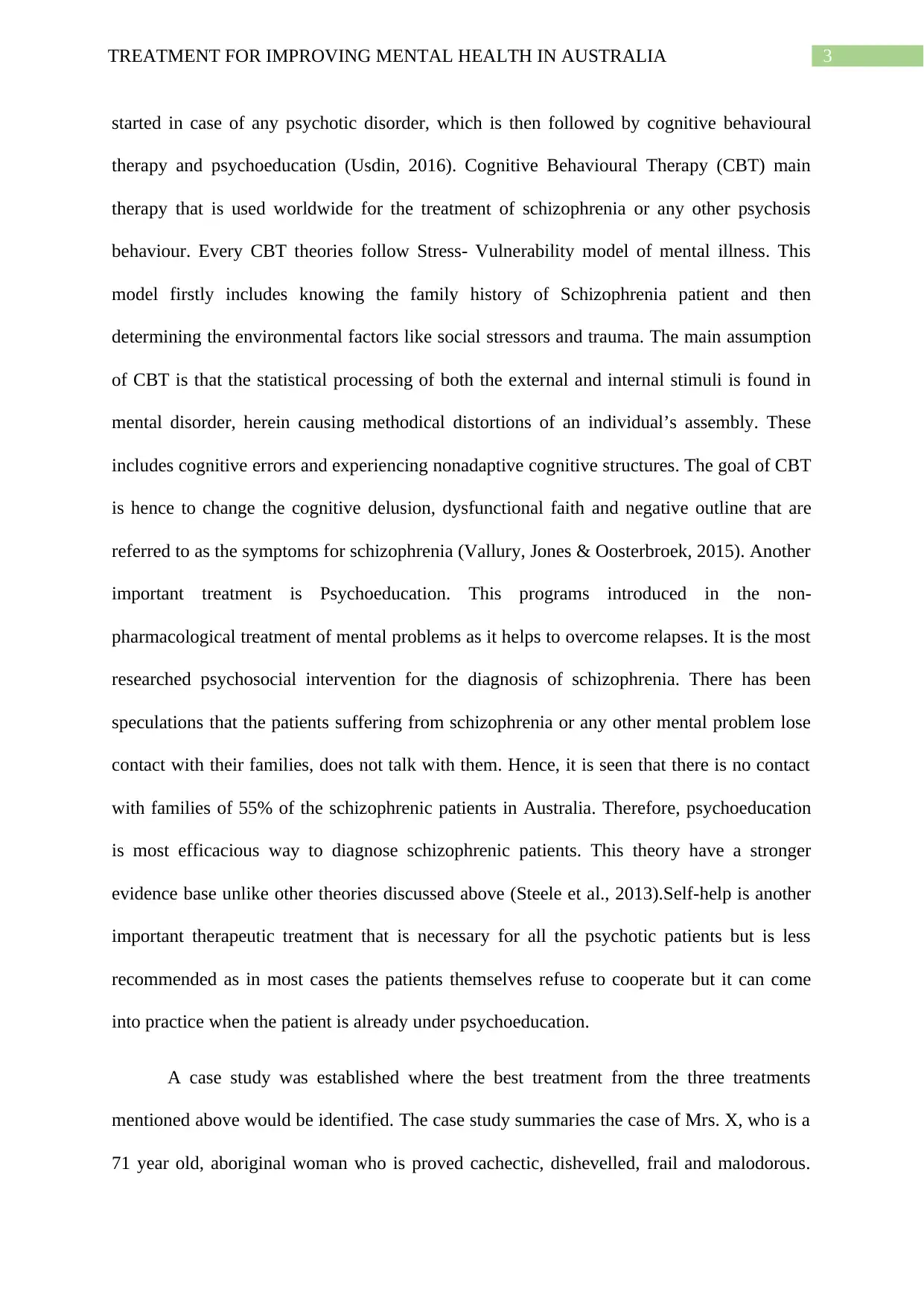
3TREATMENT FOR IMPROVING MENTAL HEALTH IN AUSTRALIA
started in case of any psychotic disorder, which is then followed by cognitive behavioural
therapy and psychoeducation (Usdin, 2016). Cognitive Behavioural Therapy (CBT) main
therapy that is used worldwide for the treatment of schizophrenia or any other psychosis
behaviour. Every CBT theories follow Stress- Vulnerability model of mental illness. This
model firstly includes knowing the family history of Schizophrenia patient and then
determining the environmental factors like social stressors and trauma. The main assumption
of CBT is that the statistical processing of both the external and internal stimuli is found in
mental disorder, herein causing methodical distortions of an individual’s assembly. These
includes cognitive errors and experiencing nonadaptive cognitive structures. The goal of CBT
is hence to change the cognitive delusion, dysfunctional faith and negative outline that are
referred to as the symptoms for schizophrenia (Vallury, Jones & Oosterbroek, 2015). Another
important treatment is Psychoeducation. This programs introduced in the non-
pharmacological treatment of mental problems as it helps to overcome relapses. It is the most
researched psychosocial intervention for the diagnosis of schizophrenia. There has been
speculations that the patients suffering from schizophrenia or any other mental problem lose
contact with their families, does not talk with them. Hence, it is seen that there is no contact
with families of 55% of the schizophrenic patients in Australia. Therefore, psychoeducation
is most efficacious way to diagnose schizophrenic patients. This theory have a stronger
evidence base unlike other theories discussed above (Steele et al., 2013).Self-help is another
important therapeutic treatment that is necessary for all the psychotic patients but is less
recommended as in most cases the patients themselves refuse to cooperate but it can come
into practice when the patient is already under psychoeducation.
A case study was established where the best treatment from the three treatments
mentioned above would be identified. The case study summaries the case of Mrs. X, who is a
71 year old, aboriginal woman who is proved cachectic, dishevelled, frail and malodorous.
started in case of any psychotic disorder, which is then followed by cognitive behavioural
therapy and psychoeducation (Usdin, 2016). Cognitive Behavioural Therapy (CBT) main
therapy that is used worldwide for the treatment of schizophrenia or any other psychosis
behaviour. Every CBT theories follow Stress- Vulnerability model of mental illness. This
model firstly includes knowing the family history of Schizophrenia patient and then
determining the environmental factors like social stressors and trauma. The main assumption
of CBT is that the statistical processing of both the external and internal stimuli is found in
mental disorder, herein causing methodical distortions of an individual’s assembly. These
includes cognitive errors and experiencing nonadaptive cognitive structures. The goal of CBT
is hence to change the cognitive delusion, dysfunctional faith and negative outline that are
referred to as the symptoms for schizophrenia (Vallury, Jones & Oosterbroek, 2015). Another
important treatment is Psychoeducation. This programs introduced in the non-
pharmacological treatment of mental problems as it helps to overcome relapses. It is the most
researched psychosocial intervention for the diagnosis of schizophrenia. There has been
speculations that the patients suffering from schizophrenia or any other mental problem lose
contact with their families, does not talk with them. Hence, it is seen that there is no contact
with families of 55% of the schizophrenic patients in Australia. Therefore, psychoeducation
is most efficacious way to diagnose schizophrenic patients. This theory have a stronger
evidence base unlike other theories discussed above (Steele et al., 2013).Self-help is another
important therapeutic treatment that is necessary for all the psychotic patients but is less
recommended as in most cases the patients themselves refuse to cooperate but it can come
into practice when the patient is already under psychoeducation.
A case study was established where the best treatment from the three treatments
mentioned above would be identified. The case study summaries the case of Mrs. X, who is a
71 year old, aboriginal woman who is proved cachectic, dishevelled, frail and malodorous.
Paraphrase This Document
Need a fresh take? Get an instant paraphrase of this document with our AI Paraphraser
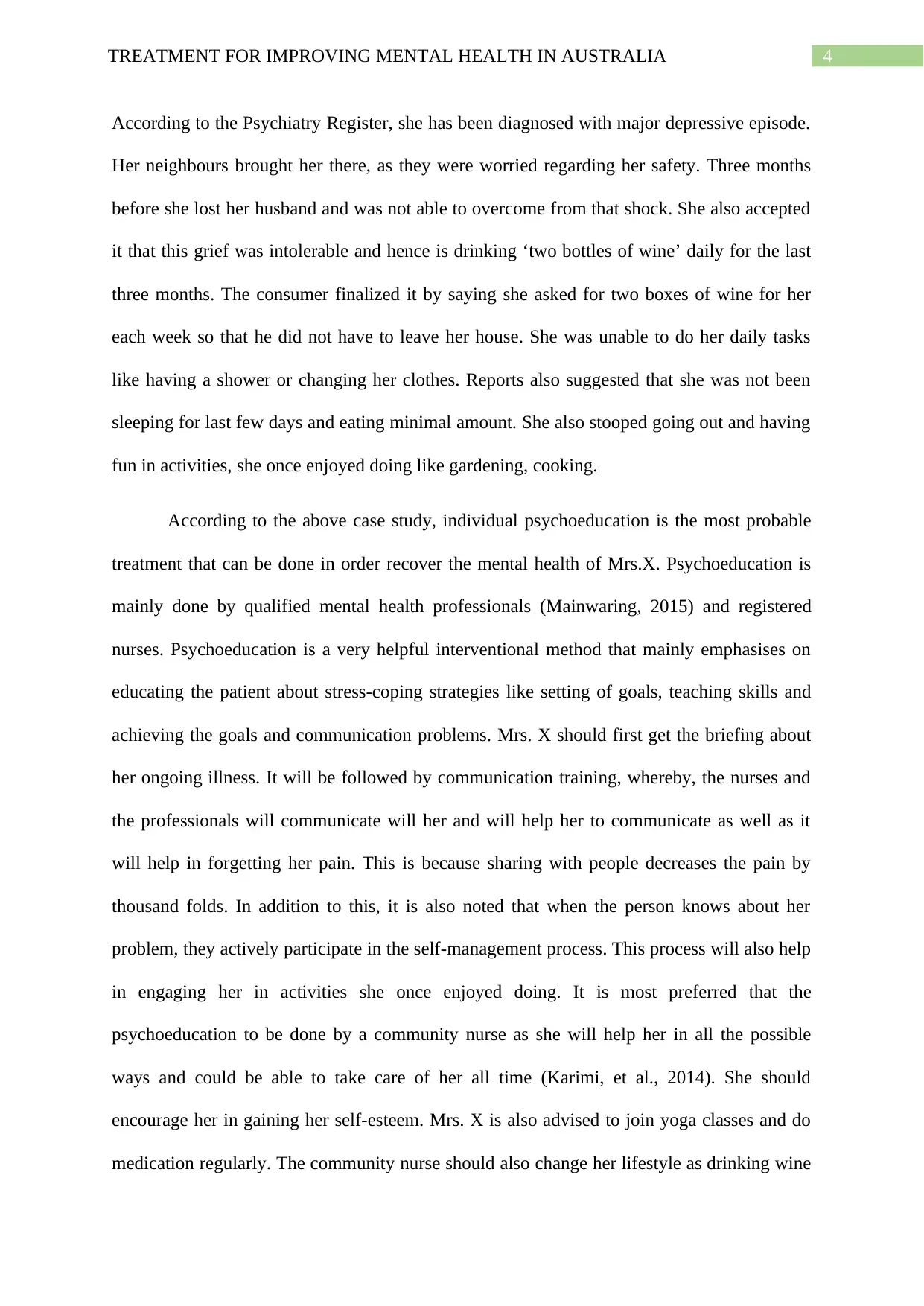
4TREATMENT FOR IMPROVING MENTAL HEALTH IN AUSTRALIA
According to the Psychiatry Register, she has been diagnosed with major depressive episode.
Her neighbours brought her there, as they were worried regarding her safety. Three months
before she lost her husband and was not able to overcome from that shock. She also accepted
it that this grief was intolerable and hence is drinking ‘two bottles of wine’ daily for the last
three months. The consumer finalized it by saying she asked for two boxes of wine for her
each week so that he did not have to leave her house. She was unable to do her daily tasks
like having a shower or changing her clothes. Reports also suggested that she was not been
sleeping for last few days and eating minimal amount. She also stooped going out and having
fun in activities, she once enjoyed doing like gardening, cooking.
According to the above case study, individual psychoeducation is the most probable
treatment that can be done in order recover the mental health of Mrs.X. Psychoeducation is
mainly done by qualified mental health professionals (Mainwaring, 2015) and registered
nurses. Psychoeducation is a very helpful interventional method that mainly emphasises on
educating the patient about stress-coping strategies like setting of goals, teaching skills and
achieving the goals and communication problems. Mrs. X should first get the briefing about
her ongoing illness. It will be followed by communication training, whereby, the nurses and
the professionals will communicate will her and will help her to communicate as well as it
will help in forgetting her pain. This is because sharing with people decreases the pain by
thousand folds. In addition to this, it is also noted that when the person knows about her
problem, they actively participate in the self-management process. This process will also help
in engaging her in activities she once enjoyed doing. It is most preferred that the
psychoeducation to be done by a community nurse as she will help her in all the possible
ways and could be able to take care of her all time (Karimi, et al., 2014). She should
encourage her in gaining her self-esteem. Mrs. X is also advised to join yoga classes and do
medication regularly. The community nurse should also change her lifestyle as drinking wine
According to the Psychiatry Register, she has been diagnosed with major depressive episode.
Her neighbours brought her there, as they were worried regarding her safety. Three months
before she lost her husband and was not able to overcome from that shock. She also accepted
it that this grief was intolerable and hence is drinking ‘two bottles of wine’ daily for the last
three months. The consumer finalized it by saying she asked for two boxes of wine for her
each week so that he did not have to leave her house. She was unable to do her daily tasks
like having a shower or changing her clothes. Reports also suggested that she was not been
sleeping for last few days and eating minimal amount. She also stooped going out and having
fun in activities, she once enjoyed doing like gardening, cooking.
According to the above case study, individual psychoeducation is the most probable
treatment that can be done in order recover the mental health of Mrs.X. Psychoeducation is
mainly done by qualified mental health professionals (Mainwaring, 2015) and registered
nurses. Psychoeducation is a very helpful interventional method that mainly emphasises on
educating the patient about stress-coping strategies like setting of goals, teaching skills and
achieving the goals and communication problems. Mrs. X should first get the briefing about
her ongoing illness. It will be followed by communication training, whereby, the nurses and
the professionals will communicate will her and will help her to communicate as well as it
will help in forgetting her pain. This is because sharing with people decreases the pain by
thousand folds. In addition to this, it is also noted that when the person knows about her
problem, they actively participate in the self-management process. This process will also help
in engaging her in activities she once enjoyed doing. It is most preferred that the
psychoeducation to be done by a community nurse as she will help her in all the possible
ways and could be able to take care of her all time (Karimi, et al., 2014). She should
encourage her in gaining her self-esteem. Mrs. X is also advised to join yoga classes and do
medication regularly. The community nurse should also change her lifestyle as drinking wine
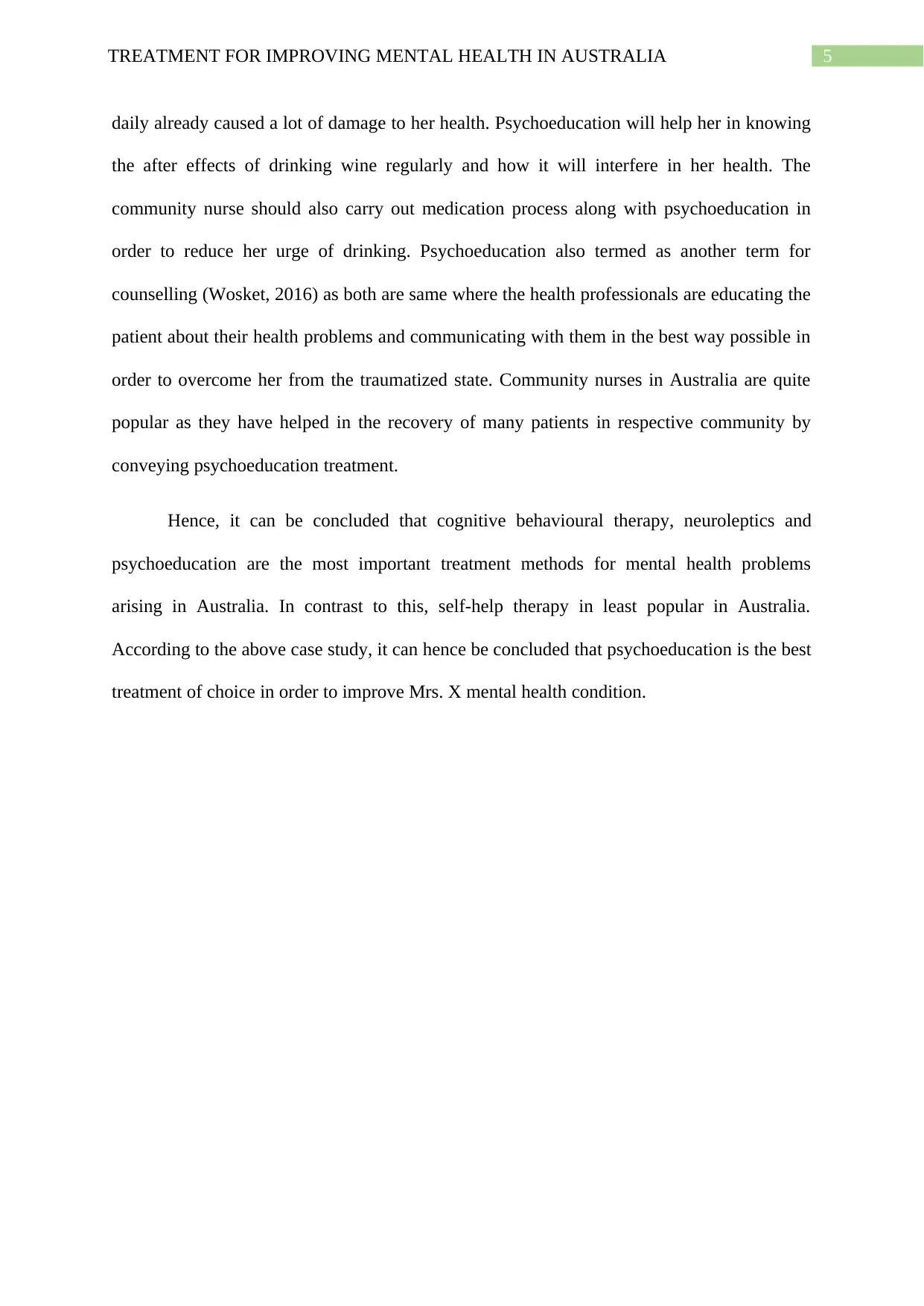
5TREATMENT FOR IMPROVING MENTAL HEALTH IN AUSTRALIA
daily already caused a lot of damage to her health. Psychoeducation will help her in knowing
the after effects of drinking wine regularly and how it will interfere in her health. The
community nurse should also carry out medication process along with psychoeducation in
order to reduce her urge of drinking. Psychoeducation also termed as another term for
counselling (Wosket, 2016) as both are same where the health professionals are educating the
patient about their health problems and communicating with them in the best way possible in
order to overcome her from the traumatized state. Community nurses in Australia are quite
popular as they have helped in the recovery of many patients in respective community by
conveying psychoeducation treatment.
Hence, it can be concluded that cognitive behavioural therapy, neuroleptics and
psychoeducation are the most important treatment methods for mental health problems
arising in Australia. In contrast to this, self-help therapy in least popular in Australia.
According to the above case study, it can hence be concluded that psychoeducation is the best
treatment of choice in order to improve Mrs. X mental health condition.
daily already caused a lot of damage to her health. Psychoeducation will help her in knowing
the after effects of drinking wine regularly and how it will interfere in her health. The
community nurse should also carry out medication process along with psychoeducation in
order to reduce her urge of drinking. Psychoeducation also termed as another term for
counselling (Wosket, 2016) as both are same where the health professionals are educating the
patient about their health problems and communicating with them in the best way possible in
order to overcome her from the traumatized state. Community nurses in Australia are quite
popular as they have helped in the recovery of many patients in respective community by
conveying psychoeducation treatment.
Hence, it can be concluded that cognitive behavioural therapy, neuroleptics and
psychoeducation are the most important treatment methods for mental health problems
arising in Australia. In contrast to this, self-help therapy in least popular in Australia.
According to the above case study, it can hence be concluded that psychoeducation is the best
treatment of choice in order to improve Mrs. X mental health condition.
⊘ This is a preview!⊘
Do you want full access?
Subscribe today to unlock all pages.

Trusted by 1+ million students worldwide
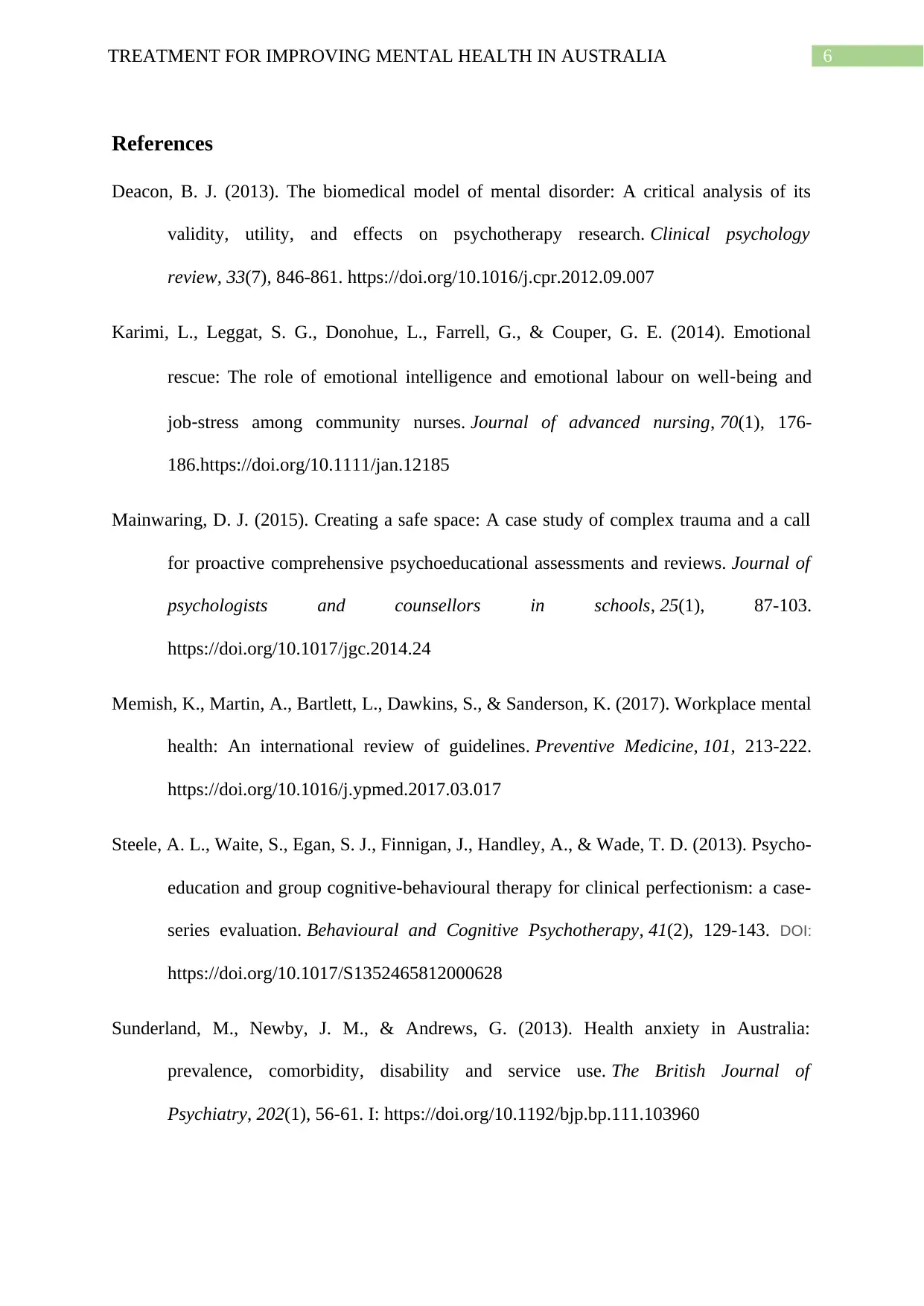
6TREATMENT FOR IMPROVING MENTAL HEALTH IN AUSTRALIA
References
Deacon, B. J. (2013). The biomedical model of mental disorder: A critical analysis of its
validity, utility, and effects on psychotherapy research. Clinical psychology
review, 33(7), 846-861. https://doi.org/10.1016/j.cpr.2012.09.007
Karimi, L., Leggat, S. G., Donohue, L., Farrell, G., & Couper, G. E. (2014). Emotional
rescue: The role of emotional intelligence and emotional labour on well‐being and
job‐stress among community nurses. Journal of advanced nursing, 70(1), 176-
186.https://doi.org/10.1111/jan.12185
Mainwaring, D. J. (2015). Creating a safe space: A case study of complex trauma and a call
for proactive comprehensive psychoeducational assessments and reviews. Journal of
psychologists and counsellors in schools, 25(1), 87-103.
https://doi.org/10.1017/jgc.2014.24
Memish, K., Martin, A., Bartlett, L., Dawkins, S., & Sanderson, K. (2017). Workplace mental
health: An international review of guidelines. Preventive Medicine, 101, 213-222.
https://doi.org/10.1016/j.ypmed.2017.03.017
Steele, A. L., Waite, S., Egan, S. J., Finnigan, J., Handley, A., & Wade, T. D. (2013). Psycho-
education and group cognitive-behavioural therapy for clinical perfectionism: a case-
series evaluation. Behavioural and Cognitive Psychotherapy, 41(2), 129-143. DOI:
https://doi.org/10.1017/S1352465812000628
Sunderland, M., Newby, J. M., & Andrews, G. (2013). Health anxiety in Australia:
prevalence, comorbidity, disability and service use. The British Journal of
Psychiatry, 202(1), 56-61. I: https://doi.org/10.1192/bjp.bp.111.103960
References
Deacon, B. J. (2013). The biomedical model of mental disorder: A critical analysis of its
validity, utility, and effects on psychotherapy research. Clinical psychology
review, 33(7), 846-861. https://doi.org/10.1016/j.cpr.2012.09.007
Karimi, L., Leggat, S. G., Donohue, L., Farrell, G., & Couper, G. E. (2014). Emotional
rescue: The role of emotional intelligence and emotional labour on well‐being and
job‐stress among community nurses. Journal of advanced nursing, 70(1), 176-
186.https://doi.org/10.1111/jan.12185
Mainwaring, D. J. (2015). Creating a safe space: A case study of complex trauma and a call
for proactive comprehensive psychoeducational assessments and reviews. Journal of
psychologists and counsellors in schools, 25(1), 87-103.
https://doi.org/10.1017/jgc.2014.24
Memish, K., Martin, A., Bartlett, L., Dawkins, S., & Sanderson, K. (2017). Workplace mental
health: An international review of guidelines. Preventive Medicine, 101, 213-222.
https://doi.org/10.1016/j.ypmed.2017.03.017
Steele, A. L., Waite, S., Egan, S. J., Finnigan, J., Handley, A., & Wade, T. D. (2013). Psycho-
education and group cognitive-behavioural therapy for clinical perfectionism: a case-
series evaluation. Behavioural and Cognitive Psychotherapy, 41(2), 129-143. DOI:
https://doi.org/10.1017/S1352465812000628
Sunderland, M., Newby, J. M., & Andrews, G. (2013). Health anxiety in Australia:
prevalence, comorbidity, disability and service use. The British Journal of
Psychiatry, 202(1), 56-61. I: https://doi.org/10.1192/bjp.bp.111.103960
Paraphrase This Document
Need a fresh take? Get an instant paraphrase of this document with our AI Paraphraser
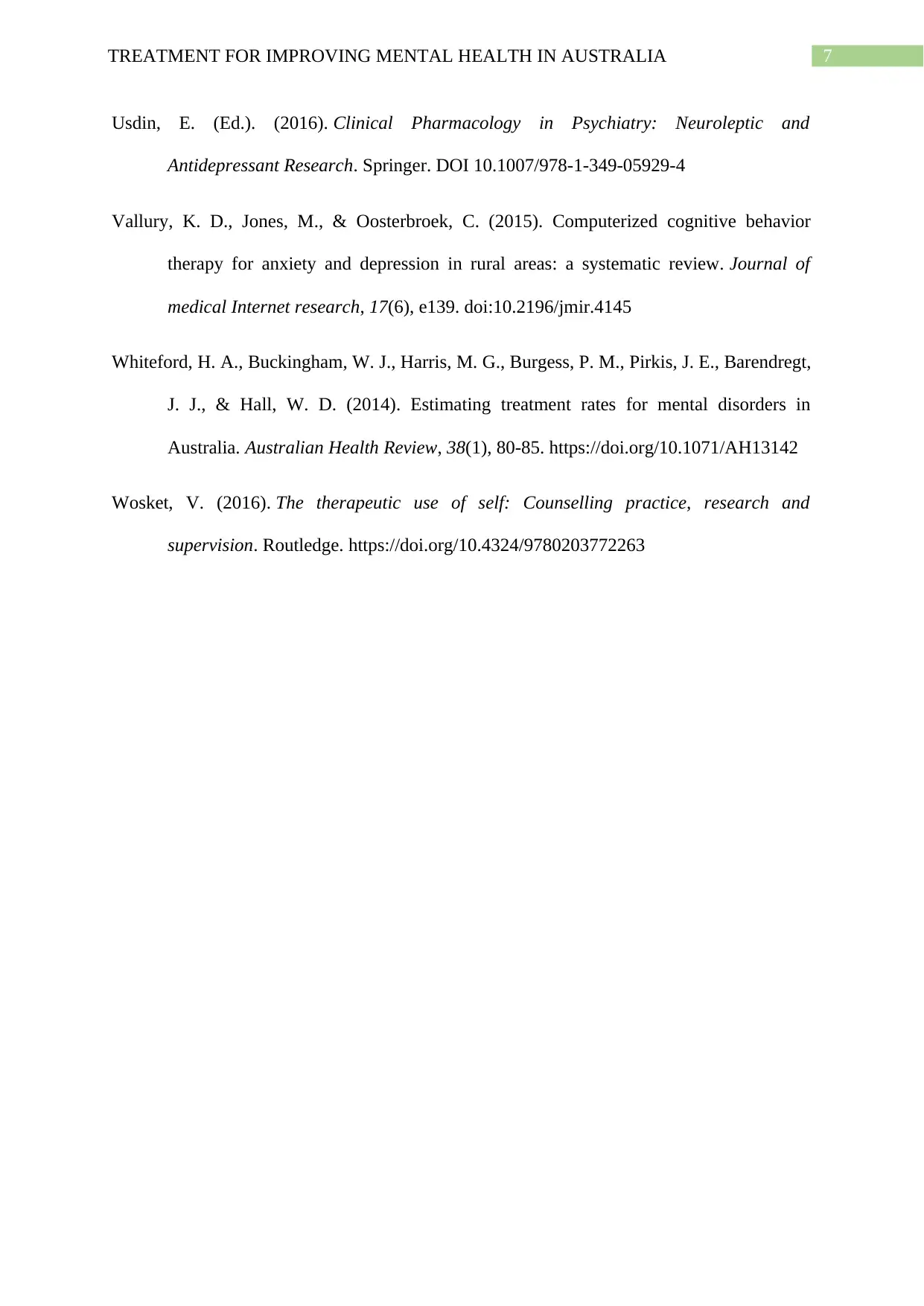
7TREATMENT FOR IMPROVING MENTAL HEALTH IN AUSTRALIA
Usdin, E. (Ed.). (2016). Clinical Pharmacology in Psychiatry: Neuroleptic and
Antidepressant Research. Springer. DOI 10.1007/978-1-349-05929-4
Vallury, K. D., Jones, M., & Oosterbroek, C. (2015). Computerized cognitive behavior
therapy for anxiety and depression in rural areas: a systematic review. Journal of
medical Internet research, 17(6), e139. doi:10.2196/jmir.4145
Whiteford, H. A., Buckingham, W. J., Harris, M. G., Burgess, P. M., Pirkis, J. E., Barendregt,
J. J., & Hall, W. D. (2014). Estimating treatment rates for mental disorders in
Australia. Australian Health Review, 38(1), 80-85. https://doi.org/10.1071/AH13142
Wosket, V. (2016). The therapeutic use of self: Counselling practice, research and
supervision. Routledge. https://doi.org/10.4324/9780203772263
Usdin, E. (Ed.). (2016). Clinical Pharmacology in Psychiatry: Neuroleptic and
Antidepressant Research. Springer. DOI 10.1007/978-1-349-05929-4
Vallury, K. D., Jones, M., & Oosterbroek, C. (2015). Computerized cognitive behavior
therapy for anxiety and depression in rural areas: a systematic review. Journal of
medical Internet research, 17(6), e139. doi:10.2196/jmir.4145
Whiteford, H. A., Buckingham, W. J., Harris, M. G., Burgess, P. M., Pirkis, J. E., Barendregt,
J. J., & Hall, W. D. (2014). Estimating treatment rates for mental disorders in
Australia. Australian Health Review, 38(1), 80-85. https://doi.org/10.1071/AH13142
Wosket, V. (2016). The therapeutic use of self: Counselling practice, research and
supervision. Routledge. https://doi.org/10.4324/9780203772263
1 out of 8
Related Documents
Your All-in-One AI-Powered Toolkit for Academic Success.
+13062052269
info@desklib.com
Available 24*7 on WhatsApp / Email
![[object Object]](/_next/static/media/star-bottom.7253800d.svg)
Unlock your academic potential
Copyright © 2020–2025 A2Z Services. All Rights Reserved. Developed and managed by ZUCOL.





